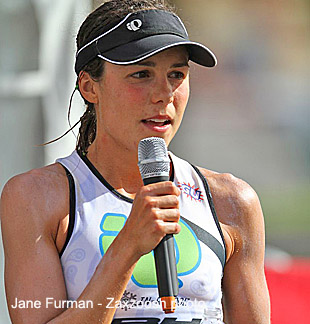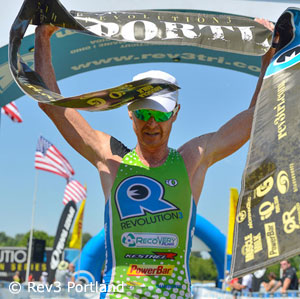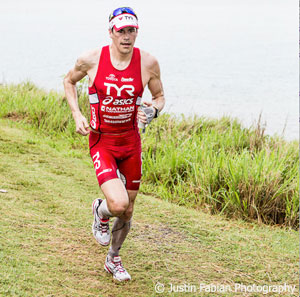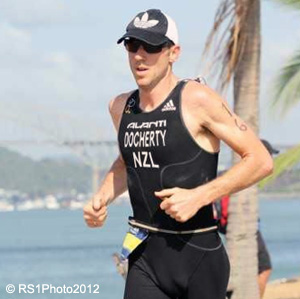Iron dreams alive but on hold
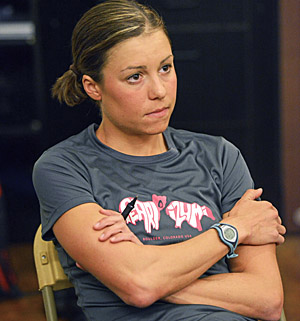
Canadian Angela Naeth has carved out a reputation as one of the sport’s great cyclists and a top Ironman 70.3 competitor on the verge of greatness. In her first three years as a pro, she set the fastest bike split in 17 races and, as a sign of her overall development, set overall course records at historic Ironman 70.3 St. Croix and at Syracuse 70.3 in 2012. For a frustrating 18 months in 2010 and 2011, she was the Runner-up Queen of Ironman 70.3, taking 8 second place finishes before breaking through with her first win at the distance at the 2011 Boulder 70.3. Since then she has won 5 races at the distance. She also showed short course speed with a 4th place finish at the Hy-Vee Elite Cup and long course promise with a win at the 2011 Leadman 250 and a 2nd place finish at Abu Dhabi with its 200-kilometer bike.
While the 30-year-old competitor has her heart set on the Ironman distance, late season injuries in 2011 and 2012 twice postponed her Iron plans, perhaps to 2014. Now coached by the legendary Mark Allen, she continues to improve her run to stoke the fires of a dream race at Kona.
Naeth was interviewed via email from her new base in Las Vegas before a highly anticipated return to Abu Dhabi.
Slowtwitch: You had a pretty darn good 2011 race season up to your breakthrough 70.3 win at Boulder. How did you injure your ankle? And what was the whiplash in emotions like when you finally broke out of your 7 or 8-race streak of second places in 70.3s slump and then promptly suffered an injury that wiped out your chance at your goal race, the Ironman 70.3 Worlds at Las Vegas?
Angela Naeth: The 2011 Boulder 70.3 was a race where I literally took all the stress of performing out of the equation and I made my own decisions pre-race week. The race prior to Boulder, [Buffalo Springs Lake 70.3 DNF in late June] was too stressful for many reasons that didn’t include the race so much as it did personal relationships and, unfortunately, left me burned out and my body shut down while racing. At the end of that race in Boulder I cried because it was more than just a race win. It was me finally overcoming that barrier of winning. The week after Boulder 70.3, I made the mistake of jumping back into training with a ˜tester” week that had me hurting by week’s end. I was pushed a bit too much and allowed myself to be pushed. At the time of the injury I wasn’t heartbroken, but quite angry and frustrated that things were so stressful and turned out the way they did. It’s true; stress comes in all forms — not just physically. Emotionally is, above all, the biggest on the list (at least for me!) I truly believe that a good coach-athlete relationship cannot be confused with a real relationship; this was the issue.
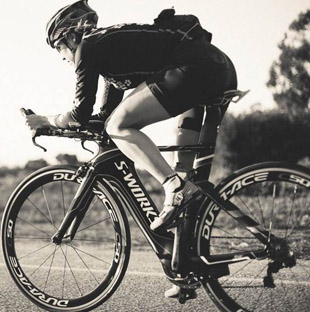
ST: How in the world did you manage to set a course record of 4:28:12 in May 2012 at St. Croix while riding the final 5 or 6 miles of the bike with a flat tire?
Angela: St. Croix is a special place, much like Kona (not in status but in history, dating back to 1988). It’s a challenge on an unforgettable course with weather patterns that can change in the blink of an eye. That didn’t happen last year – it started with rain that continued throughout the day, making the course a sloppy mess. The challenge of riding in the mud and muck, on roads laden with potholes that were hidden by the giant puddles, allowed me to just give myself to the race itself. It was like being a kid out there again.
ST: Give us some tips on when and how to ride with a flat tire? How much luck was involved? Were you tempted to try to fix replace the tube or fix the flat?
Angela: The flat tire happened on the ascent of the final climb (that’s done twice on the course). I attacked the hill relentlessly with the rear tire flat, knowing that the descent was going to have to be a slow one. At the time I had a gap of 2 minutes and knew in my head that, with my bike as mucked up as it was, and the fact that I was riding tubulars and it was a rear flat, there was no way I was going to be able to fix it without losing my position in the race. I rode cautiously, but the good thing was that having a tubular allows you to ride without too much worry. The disc was solid, just bumpy and heavy! I just had to kick into overdrive and get this bike back home! As far as tips, I’d say use your judgment — a tubular is solid to ride on (from my experience). If you’re 75% the way there, and you’re in good position, then ride it like it’s stolen!
ST: How did you improve your run from someone who blasts the bike and holds on for dear life on the run to someone who can, from time to time, run with the likes of Jodie Swallow, Leanda Cave and Melissa Hauschildt? Last year you posted the fastest runs at Rev3 Portland (1:25:37), Syracuse 70.3 (1:23:23) and St. Croix (1:25:17), while running your fastest 70.3 run (1:21:44) at Panama 70.3.
Angela: Those ladies are fast, but you’re forgetting to mention one of the fastest runners on the circuit in the 70.3 distance, Kelly Williamson [who ran 1:16 at Panama 70.3] I think it’s a matter of patience. I’m definitely an athlete who built fitness on the bike and, after a few years, it’s finally translated over to the run. Of course, including some speed sessions and following a program that works helps too!
ST: Has your run improvement whetted your appetite for taking on the world at the Ironman distance?
Angela: As far as my appetite, I think this is answered above in some way; my passion for Ironman has always been there. Leanda’s performance in Kona was inspiring and I know that I’d love to compete at this race.
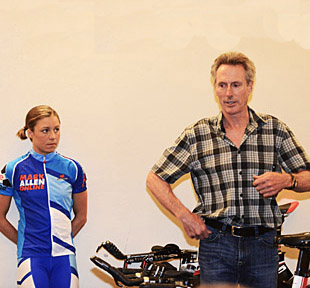
ST: Can you tell us what it has been like to run under such widely varying coaching styles in the last 3 or 4 years? You have worked with Brett Sutton briefly, Chuckie Veylupek for most of your pro career to Mark Allen starting in November 2011.
Angela: It’s been a whirlwind, for sure, but I’ve learned a lot from each of them. Most importantly though, I’ve learned that no one coach has all the answers that will work for you. That was one of those things you have to learn for yourself. (And I’m still learning!)
Brett was tough. He was your best friend one day and your worst enemy the next. I feared him and don’t see this as a good coach-athlete relationship. I know he wanted the best for me, but it was a tough situation that led to me pushing too much and to him assuming I was over-thinking the pain I had in my leg – which further made me not listen to my own body. It was a short term stint, and perhaps now that I have developed a better frame of mind and understanding of myself, we’d work differently together.
With Chuck, our dynamics were too difficult. At first we seemed to be a good team, which led to us dating. However, we were a team that fought a lot and I’m the sensitive type that doesn’t work with anger, hatred and/or fear very well. It’s a difficult situation when your personal relationship crosses with an athlete-coach relationship, and it’s even more difficult to perform when you know that both relationships are ultimately failing. Chuck supported me while I was his athlete and took me from a grass-roots newbie to someone who could contend at high-professional races. Unfortunately, the barriers that we had to overcome were too great. This led me to seek where Chuck got most of his philosophies, Mark Allen.
Mark’s not only a coach but also my biggest mentor. I smile just writing about him. I think we’ve had more emails and conversations about life than triathlon! How we work together is based on trust and support, and I have nothing but respect for everything he says and writes. This, I believe, is what makes a coach-athlete relationship work. The nuts and bolts of a training schedule are not what’s going to help an athlete win their next race. With that said Mark Allen’s approach is well thought out and changes, if needed, according to how I respond. It’s s that unquestionable faith, trust, mutual respect, and love, for a better word, within that relationship that creates success. This is the only coaching relationship that works for me.
ST: After shifting your focus to longer distance races in 2010, how encouraging was it to finish 4th at the Olympic distance, non-drafting 2012 Hy-Vee Elite Cup?
Angela: I hadn’t shifted my focus back to short distance, but rather decided to take the opportunity to race Hy-Vee because I qualified. I must say, this was one of the most exhilarating races I’ve competed in and it has me hungry for more! Two hours of racing is much more exciting – both emotionally and mentally. You’re all-out from the gun, yet there are tactics. Hy-Vee was a race where I felt that my cycling shined through. It was a technical course and I was able to use the corners and hills to my advantage. I believe this was truly the first race I pushed myself to the finish line and had that out-of-body experience.
ST: How encouraging was it to get passed by Melissa Hauschildt at Hy-Vee, then take down this formidable runner late in the race?
Angela: Melissa is an amazing runner and to put out a performance like that on an Olympic course in the last 500 metres was very surprising to me. That last lap was an interesting one. I had my boyfriend, Paul Duncan, screaming at me each lap with such passion that it was addicting. Melissa passed me and I stayed roughly 10 metres back. There was one last uphill and turn to the finish and something clicked in my head. It was as if someone or something honestly helped me push through a barrier that was held in front of me for so long. Perhaps it was that central governor of mine that I finally shut down! Perhaps because this race wasn’t on the radar for me — I was more relaxed and had fun doing it. It was that place of perfection that I was striving for all year. Mark and I conversed about this many times leading up to these last few races. It was an experience that I’ll never forget.
ST: What happened to make you crash at Las Vegas last Fall? Is there anything about it that you learned to avoid such a disaster in the future?
Angela: Yes, KEEP YOUR HEAD UP! 🙂 I explained the crash in full in my blog. But in short, I’m not sure how, but I lost focus and hit a rumble strip, breaking my front wheel. That was what ultimately led me to hit the pavement. My biggest lesson learned: I put too much pressure on myself for this race. I needed to keep the mindset that I had in Hy-Vee. Also, I think racing Hy-Vee just 6 days before took a lot out of me mentally and physically. I need to continue to learn how to harness recovery after these big bouts and let things come without pushing them — on and off the race course!
ST: How long did it take for you to recover from your road rash and other injuries from Las Vegas?
Angela: Quite a while. I had to get a number of stitches in my ankle that ultimately led to an infection. The road rash on the torso and arm was very painful and took roughly a month to be patched up. The ankle was the factor that led to me get some much-needed down time after the year I had – good and bad!
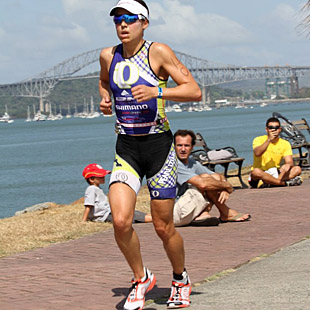
ST: You mentioned two years ago that you were thinking of taking on the Ironman. Did your ankle injury in August 2011 delay that part of the plan? Did your bike crash at Las Vegas 70.3 Worlds last September delay that quest again? When will you try the Ironman?
Angela: Ironman has always been in the background for me. At first I never believed I could be competitive, let alone run 26.2 miles in one bout… and to this day, perhaps I still have some of this mindset! Am I scared to try? A little, yes. But ultimately I desire to do this distance more than ever. My plan was to race IM Melbourne this year but it just wasn’t in the cards with the way my winter has played out.
ST: Why specifically did you rule out Melbourne this year?
Angela: With my crash at 70.3 Worlds I have no base on which to lay down the foundation for both 70.3 Worlds and Kona without over-racing. I’d rather perform to my ability during the competitive season, so I’m taking each month this year leading up to Worlds in conjunction with where I sit for the championship race.
ST: In addition to their fame and high standing in the ranks of great racing bikes, what about the Specialized Shiv do you like? What about it makes it faster and improves your already proven prowess as one of the most formidable women triathlon cyclists?
Angela: I ultimately decided to sign with Specialized because of the Shiv. I wrote a blog about my experience with the Shiv [25 January 2013 entry on http://www.angelanaeth.com/blog.html] and it’s best to check that out. In short, it’s aero, fast in the crosswinds, and really is a cut above any bike frame I’ve tried. I’m excited to test it out for real in a race!
ST: Where do you think you stand among the great women triathlon cyclists including Nikki Butterfield (before her latest pregnancy hiatus), Caroline Steffen (4:35 split at Melbourne), Chrissie Wellington (before retirement), Julie Dibens (when healthy), Karin Thuerig, Yvonne van Vlerken (has a 4:40 IM split to her credit), and the other top riders?
Angela: Nikki was fast after her pregnancy! 🙂 All of these women have proven themselves time and again on the bike and I hope to make my mark as one of them in the Ironman distance. My results in a few longer distance events (a second at Abu Dhabi and a win at Leadman 250) do show my ability, and my season last year has proven that I have a strong cycling leg. Only time will tell!
ST: How do you stand as a runner against the best in the sport – let’s say Mirinda Carfrae, Catriona Morrison, Melissa Hauschildt, Heather Jackson, Kelly Williamson – at the Ironman 70.3 distance? Where do you think you will fit in as a runner at the Ironman marathon?
Angela: This will be something to find out! Ironman will be a new game, that’s for sure. Working with Mark has opened my eyes up to new possibilities, and I foresee good things.
ST: Are there any indications of how well you can run the marathon in your training and racing up to this point?
Angela: At this point, I’m not sure. I think I’m made to go long…I just have to stay healthy.
ST: In addition to feeling admiration and warmth at her friendly smile, what did you think when Natascha Badmann at age 45 zoomed past you on the bike at Ironman 70.3 Panama?
Angela: She was out of this world. She blew by me like I was standing still, which led me to kick it up a notch. I think she made me realize how much more I had in the tank. She’s very friendly and so supportive. When I crashed in Las Vegas and was limping through the run, she passed me and told me to keep going. It was her words that helped me get to the finish line [in 17th place].
ST: Will you do any preliminary scouting of Kona?
Angela: I will be heading over to the Big Island for a solid race recon and to learn with Mark what this race is all about. If all goes well, I’ll do my first Ironman post-Vegas aimed at qualifying for Kona in 2014.
ST: How has Mark Allen improved your strengths as a triathlete?
Angela: Mark has helped me hone into my strengths by providing a program that works for me. He’s helped me incorporate speed work when the time was right. He’s helped me gain strength I found within myself while racing and helped keep my head on straight! I tend to overthink and ruminate way too much. He keeps me forging ahead.
ST: What is the essential quality that makes Mark Allen unique?
Angela: He’s unlike any guy I’ve met. He’s trusting, understanding and optimistic. I guess that’s three!
ST: Have you taken in any of Mark’s philosophic approach to life and sport?
Angela: Yes, I’ve read his book Fit Soul, Fit Body a number of times and refer back to it often. Mark and I converse a lot via email and I tend to ask some pretty philosophical questions! Paul (my boyfriend) and I went to one of his Fit Soul, Fit Body retreats in November, which helped solidify some of Mark’s teachings. I’m still learning and very intrigued by what I’ve read and experienced thus far. I’ve been able to see [Allen’s friend, seminar partner and adviser] Brant Secunda a few times and he’s helped me a lot.
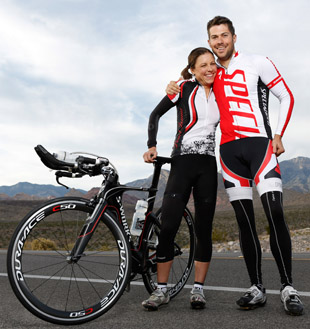
ST: Tell a little about your boyfriend and how you met.
Angela: Paul Duncan is a Staff Sgt. with the National Guard working in recruiting and he is a triathlon coach. I met him at last year’s Leadman 125 race in Vegas which, unfortunately, no longer exists. He was the pro liaison. Fortunately, I was the only athlete that required his services – or else I am sure he’d be someone else’s girlfriend! And for this, I consider myself the lucky one! His duties were to take care of me, pick me up at the airport and be there if I needed anything. He was a breath of fresh air, and from the moment I set eyes on him, I was smiling. That says everything.
ST: Why did you click?
Angela: I don’t have a solid explanation other than I was smiling as soon as we met.
ST: How much has his support helped you?
Angela: He has the same passion for this sport that I do and he’s willing to go to bed at 7:30 pm! Ha! He’s someone I can go to for anything — I know he’d do anything for me. We work as a team with everything. And this, I believe, is key for any relationship.
ST: How has he changed you? And you him?
Angela: He’s opened my eyes to what a relationship takes. We’ve been honest with one another from the beginning and I’ve learned to trust him and he, me. Of course, things aren’t always peachy, but we know how to stop any arguments that would lead to wrong assumptions. He’s taught me patience, and to live a little outside of the realm of just training. As for my influence? Perhaps I’ve helped him clean up a little more. 🙂
ST: You surely have a very nice and sportsmanlike demeanor and are very polite and generous in your comments about other racers. But your killer instinct in competition seems to be a work in progress. Do you have any difficulty overcoming your essential niceness while racing killer competitors?
Angela: Yes and no. I’ve made a few mistakes in some races to support other racers only to be handed a big slap in the face and beaten at my own game. I’ve since learned that a race is far more than just swimming, biking and running fast – tactics are important. And one of these includes disclosing nothing of how you’re feeling and playing the game of competition: (wo)man against (wo)man.
ST: Do you still harbor dreams of becoming an emergency room physician? Is that dream spurred by a desire to get on the less painful other side of the doctor-patient relationship?
Angela: Yes but that's been put on the side for now.




